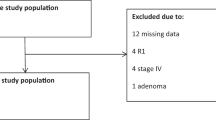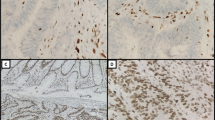Abstract
Background and aims
The incidence of double primary malignancies (DPM) is known to be higher in colorectal cancer patients than the general population. And, the role of microsatellite instability (MSI) in DPM has been previously studied. We evaluated the clinical features and association between MSI and colorectal cancer patients with DPM.
Materials and methods
From September 1994 to May 2004, we reviewed 2,301 colorectal cancer patients with regard to secondary primary malignancies. A subgroup analysis was performed for MSI after January 2003.
Results
One hundred forty-five patients (6.3%) had a DPM identified. In DPM group, 57 patients had a synchronous DPM (39.3%), and 88 patients had a metachronous malignancy (60.7%). Male gender (p < 0.001) and colon cancer (p < 0.001) were the factors related with the development of the DPM. Most of the second malignancies occurred within 3 years after the primary operation. The common second malignancies were stomach (58 patients, 40%) and lung (21 patients, 14.5%). In the subgroup analysis, there was a higher frequency of DPM in the MSI group when compared to the microsatellite stable group (p = 0.021).
Conclusions
The careful pre- and postoperative evaluation should be paid for detecting DPM as well as for detecting recurrence in colorectal cancer patients. The results of this study suggest that MSI might be a useful marker for the detection of DPM in colorectal cancer patients.



Similar content being viewed by others
Reference
Watanabe S, Kodama T, Shimosato Y, Arimoto H, Sugimura T, Suemasu K, Shiraishi M (1984) Multiple primary cancers in 5,456 autopsy cases in the National Cancer Center of Japan. J Natl Cancer Inst 72:1021–1027
Go WS (1932) Multiple primary malignant tumors: a survey of the literature and a statistical study. Am J Cancer 16:1358–1414
Horii A, Han HJ, Shimada M, Yanagisawa A, Kato Y, Ohta H, Yasui W, Tahara E, Nakamura Y (1994) Frequent replication errors at microsatellite loci in tumors of patients with multiple primary cancers. Cancer Res 54:3373–3375
Tsukuma H, Fujimoto I, Hanai A, Hiyama T, Kitagawa T, Kinoshita N (1994) Incidence of second primary cancers in Osaka residents, Japan, with special reference to cumulative and relative risks. Jpn J Cancer Res 85:339–345
Evans HS, Moller H, Robinson D, Lewis CM, Bell CM, Hodgson SV (2002) The risk of subsequent primary cancers after colorectal cancer in southeast England. Gut 50:647–652
Lee TK, Barringer M, Myers RT, Sterchi JM (1982) Multiple primary carcinomas of the colon and associated extracolonic primary malignant tumors. Ann Surg 195:501–507
Maruyama H, Hasuike Y, Furukawa J, Naoi M, Takata N, Yayoi E, Okamura J, Okamoto S (1992) Multiple colorectal carcinomas and colorectal carcinoma associated with extracolonic malignancies. Surg Today 22:99–104
Ueno M, Muto T, Oya M, Ota H, Azekura K, Yamaguchi T (2003) Multiple primary cancer: an experience at the Cancer Institute Hospital with special reference to colorectal cancer. Int J Clin Oncol 8:162–167
Yamamoto S, Yoshimura K, Ri S, Fujita S, Akasu T, Moriya Y (2006) The risk of multiple primary malignancies with colorectal carcinoma. Dis Colon Rectum 49:S30–S36
Jemal A, Siegel R, Ward E, Murray T, Xu J, Smigal C, Thun MJ (2006) Cancer statistics, 2006. CA Cancer J Clin 56:106–130
Ikeda Y, Saku M, Kawanaka H, Nonaka M, Yoshida K (2003) Features of second primary cancer in patients with gastric cancer. Oncology 65:113–117
Risinger JI, Berchuck A, Kohler MF, Watson P, Lynch HT, Boyd J (1993) Genetic instability of microsatellites in endometrial carcinoma. Cancer Res 53:5100–5103
Han HJ, Yanagisawa A, Kato Y, Park JG, Nakamura Y (1993) Genetic instability in pancreatic cancer and poorly differentiated type of gastric cancer. Cancer Res 53:5087–5089
Brown SR, Finan PJ, Hall NR, Bishop DT (1998) Incidence of DNA replication errors in patients with multiple primary cancers. Dis Colon Rectum 41:765–769
Kim HS, Cho NB, Yoo JH, Shin KH, Park JG, Kim YI, Kim WH (2001) Microsatellite instability in double primary cancers of the colorectum and stomach. Mod Pathol 14:543–548
Vasen HF, Mecklin JP, Khan PM, Lynch HT (1991) The International Collaborative Group on Hereditary Non-Polyposis Colorectal Cancer (ICG-HNPCC). Dis Colon Rectum 34:424–425
DeVita VT HS, Rosenberg SA (eds) (2001) Cancer: principles and practice of oncology, 6th edn. Lippincott, Williams & Wilkins, Philadelphia
Dong C, Hemminki K (2001) Multiple primary cancers of the colon, breast and skin (melanoma) as models for polygenic cancers. Int J Cancer 92:883–887
Liu YY, Chen YM, Yen SH, Tsai CM, Perng RP (2002) Multiple primary malignancies involving lung cancer—clinical characteristics and prognosis. Lung Cancer 35:189–194
Hemminki K, Boffetta P (2004) Multiple primary cancers as clues to environmental and heritable causes of cancer and mechanisms of carcinogenesis. IARC Sci Publ 157:289–297
Heard A, Roder D, Luke C (2005) Multiple primary cancers of separate organ sites: implications for research and cancer control (Australia). Canc Causes Contr 16:475–481
Ahmed F, Goodman MT, Kosary C, Ruiz B, Wu XC, Chen VW, Correa CN (2006) Excess risk of subsequent primary cancers among colorectal carcinoma survivors, 1975–2001. Cancer 107:1162–1171
asubuchi S, Konishi F, Togashi K, Okamoto T, Senba S, Shitoh K, Kashiwagi H, Kanazawa K, Tsukamoto T (1999) The significance of microsatellite instability in predicting the development of metachronous multiple colorectal carcinomas in patients with nonfamilial colorectal carcinoma. Cancer 85:1917–1924
Ohtani H, Yashiro M, Onoda N, Nishioka N, Kato Y, Yamamoto S, Fukushima S, Hirakawa-Ys Chung K (2000) Synchronous multiple primary gastrointestinal cancer exhibits frequent microsatellite instability. Int J Cancer 86:678–683
Liu B, Parsons R, Papadopoulos N, Nicolaides NC, Lynch HT, Watson P, Jass JR, Dunlop M, Wyllie A, Peltomaki P, de la Chapelle A, Hamilton SR, Vogelstein B, Kinzler KW (1996) Analysis of mismatch repair genes in hereditary non-polyposis colorectal cancer patients. Nat Med 2:169–174
Gonzalez-Aguilera JJ, Nejda N, Fernandez FJ, Medina V, Gonzalez-Hermoso F, Barrios Y, Moreno Azcoita M, Fernandez-Peralta AM (2003) Genetic alterations and MSI status in primary, synchronous, and metachronous tumors in a family with hereditary nonpolyposis colorectal cancer (HNPCC). Am J Clin Oncol 26:386–391
Boland CR, Thibodeau SN, Hamilton SR, Sidransky D, Eshleman JR, Burt RW, Meltzer SJ, Rodriguez-Bigas MA, Fodde R, Ranzani GN, Srivastava S (1998) A National Cancer Institute Workshop on Microsatellite Instability for cancer detection and familial predisposition: development of international criteria for the determination of microsatellite instability in colorectal cancer. Cancer Res 58:5248–5257
Kang GH, Yoon GS, Lee HK, Kwon YM, Ro JY (1999) Clinicopathologic characteristics of replication error-positive gastric carcinoma. Mod Pathol 12:15–20
Author information
Authors and Affiliations
Corresponding author
Rights and permissions
About this article
Cite this article
Yun, H.R., Yi, L.J., Cho, Y.K. et al. Double primary malignancy in colorectal cancer patients—MSI is the useful marker for predicting double primary tumors. Int J Colorectal Dis 24, 369–375 (2009). https://doi.org/10.1007/s00384-008-0541-x
Accepted:
Published:
Issue Date:
DOI: https://doi.org/10.1007/s00384-008-0541-x




